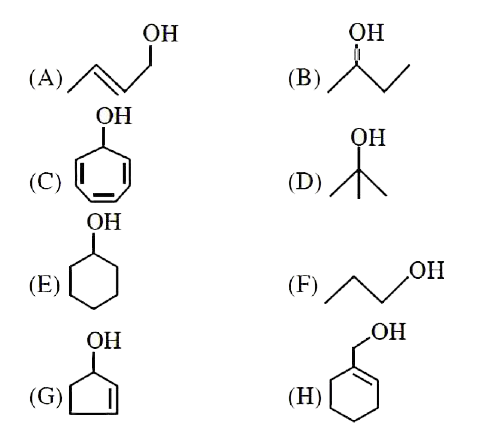How many of the structurally isomeric pentyl alcohols will produce immediate turbidity in Lucas test?
The correct Answer is:1
To determine how many structurally isomeric pentyl alcohols will produce immediate turbidity in the Lucas test, we need to analyze the structure of pentyl alcohols and their reactivity in the Lucas test.
1. Understanding the Lucas Test:
The Lucas test is used to differentiate between primary, secondary, and tertiary alcohols based on their reactivity with concentrated hydrochloric acid (HCl).
- Primary alcohols react slowly and may take up to 30 minutes to show turbidity.
- Secondary alcohols react faster, typically within 5 to 10 minutes.
- Tertiary alcohols react almost immediately, often within 30 seconds, producing a cloudy solution due to the formation of an insoluble alkyl halide.
2. Identifying Pentyl Alcohols:
Pentyl alcohols are alcohols with five carbon atoms. The general formula for pentyl alcohol is C5H11OH. The structural isomers of pentyl alcohol include:
- 1-Pentanol (primary)
- 2-Pentanol (secondary)
- 3-Pentanol (secondary)
- 2-Methyl-1-butanol (primary)
- 3-Methyl-1-butanol (primary)
- 2-Methyl-2-butanol (tertiary)
- 3-Methyl-2-butanol (tertiary)
3. Analyzing Each Isomer:
- 1-Pentanol: Primary alcohol, will not produce immediate turbidity.
- 2-Pentanol: Secondary alcohol, will not produce immediate turbidity.
- 3-Pentanol: Secondary alcohol, will not produce immediate turbidity.
- 2-Methyl-1-butanol: Primary alcohol, will not produce immediate turbidity.
- 3-Methyl-1-butanol: Primary alcohol, will not produce immediate turbidity.
- 2-Methyl-2-butanol: Tertiary alcohol, will produce immediate turbidity.
- 3-Methyl-2-butanol: Tertiary alcohol, will produce immediate turbidity.
4. Conclusion:
Among the isomeric pentyl alcohols, only the tertiary alcohols (2-Methyl-2-butanol and 3-Methyl-2-butanol) will produce immediate turbidity in the Lucas test. Therefore, there are 2 structurally isomeric pentyl alcohols that will produce immediate turbidity.
Final Answer:
2 structurally isomeric pentyl alcohols will produce immediate turbidity in the Lucas test.
The Lucas test is used to differentiate between primary, secondary, and tertiary alcohols based on their reactivity with concentrated hydrochloric acid (HCl).
- Primary alcohols react slowly and may take up to 30 minutes to show turbidity.
- Secondary alcohols react faster, typically within 5 to 10 minutes.
- Tertiary alcohols react almost immediately, often within 30 seconds, producing a cloudy solution due to the formation of an insoluble alkyl halide.
Pentyl alcohols are alcohols with five carbon atoms. The general formula for pentyl alcohol is C5H11OH. The structural isomers of pentyl alcohol include:
- 1-Pentanol (primary)
- 2-Pentanol (secondary)
- 3-Pentanol (secondary)
- 2-Methyl-1-butanol (primary)
- 3-Methyl-1-butanol (primary)
- 2-Methyl-2-butanol (tertiary)
- 3-Methyl-2-butanol (tertiary)
- 1-Pentanol: Primary alcohol, will not produce immediate turbidity.
- 2-Pentanol: Secondary alcohol, will not produce immediate turbidity.
- 3-Pentanol: Secondary alcohol, will not produce immediate turbidity.
- 2-Methyl-1-butanol: Primary alcohol, will not produce immediate turbidity.
- 3-Methyl-1-butanol: Primary alcohol, will not produce immediate turbidity.
- 2-Methyl-2-butanol: Tertiary alcohol, will produce immediate turbidity.
- 3-Methyl-2-butanol: Tertiary alcohol, will produce immediate turbidity.
Among the isomeric pentyl alcohols, only the tertiary alcohols (2-Methyl-2-butanol and 3-Methyl-2-butanol) will produce immediate turbidity in the Lucas test. Therefore, there are 2 structurally isomeric pentyl alcohols that will produce immediate turbidity.
2 structurally isomeric pentyl alcohols will produce immediate turbidity in the Lucas test.
Topper's Solved these Questions
- ALCOHOLS, PHENOLS AND ETHERSBook:PRADEEPChapter:ALCOHOLS, PHENOLS AND ETHERSExercise:COMPETITION FOCUS JEE (MAIN AND ADVANCED)/MEDICAL ENTRANCES SPECIAL (ASSERTION-REASON TYPE QUESTIONS-VII) Type-I
Explore 5 Videos
- ALCOHOLS, PHENOLS AND ETHERSBook:PRADEEPChapter:ALCOHOLS, PHENOLS AND ETHERSExercise:COMPETITION FOCUS JEE (MAIN AND ADVANCED)/MEDICAL ENTRANCES SPECIAL (ASSERTION-REASON TYPE QUESTIONS-VII) Type-II
Explore 13 Videos
- ALCOHOLS, PHENOLS AND ETHERSBook:PRADEEPChapter:ALCOHOLS, PHENOLS AND ETHERSExercise:COMPETITION FOCUS JEE (MAIN AND ADVANCED)/MEDICAL ENTRANCES SPECIAL (MATRIX-MATCH TYPE QUESTIONS-V)
Explore 1 Video
- ALDEHYDES, KETONES AND CARBOXYLIC ACIDS Book:PRADEEPChapter:ALDEHYDES, KETONES AND CARBOXYLIC ACIDS Exercise:IMPORTANT QUESTIONS FOR BOARD EXAMINATION
Explore 29 Videos
Similar Questions
Knowledge Check
The number of isomeric pentyl alcohols possible are
ATwoBFourCSixDEightThe number of isomeric pentyl alcohols possible is
ATwoBFourCSixDEightThe C4H10O (alcohols) produces immediate terbidity with Lucas reagent the alcohol is
ACH3−CH2−CH2−CH2−OHB(CH3)2CH−CH2−OHCCH3CHOHC2H5D(CH3)3C−OH
How many of strucurally isomeric pentyl alcohols wil give immediate turbidiy in Lucas reagent ?
View SolutionHow many structurally isomeric pentyl alcohols will give immediate turbidity with lucas reagent ?
View SolutionHow many alcohols give
immediate turbidity on heating
with luca's Reagent ?

View SolutionWhich alcohol gives instant turbidity with Lucas regent :
View SolutionWhich alcohol will give immediate turbidity on shaking with HCl at room temperature ?
View Solution

